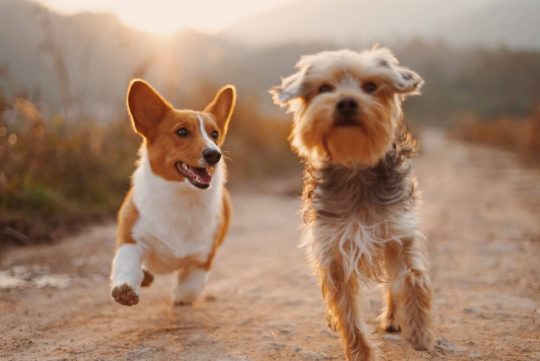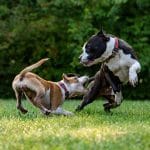Aggression
Your dog can be aggressive for a multitude of reasons. Much like humans, they can be hard to read. They have their own quirks and personalities, but a lot of negative behavior can be controlled.
The term “aggression” can refer to a wide range of behaviors, and if this aggression goes unmanaged, it could result in an attack.
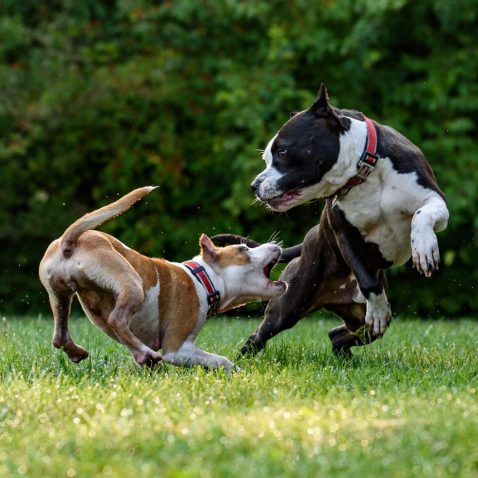
Signs of Aggression
There are plenty of things to look out for that may suggest your dog is being aggressive. Many of the signs, such as baring teeth and snarling are obvious, but there are some subtleties that you must be aware of when it comes to dog behavior.
The most common signs of aggression in dogs are:
- Stiff body posture
- Bites (from light nips to piercing bites)
- Snarling
- Baring teeth
- Pinned back ears
- Tail raised and wagging stiffly
Why is My Dog Aggressive?
In order to control your dog’s aggression, you must look out for the triggers. What is making your dog aggressive?
Unless your dog has always had a short temperament, dogs don’t usually become violent out of the blue. There are various causes, ranging from neglect to trying to establish dominance.
Pain
Dogs have limited ways of expressing how they are feeling. If your usually relaxed dog suddenly becomes showing the above signs of aggression, it’s important to consider that your dog may be poorly.
Pain is a huge cause of aggression in dogs, and if your dog is experiencing major discomfort, you need to get to the root of it. Always get advice from your veterinarian before treating your dog yourself.
Fear
If your dog is in a scary situation, it can be hard to predict how he’ll react. Fear can change a dog’s behavior in seconds, much like with humans.
Like humans, dogs have a fight or flight response. When this is triggered, there can be little warning signs (especially with past trauma). Once a dog feels the need to defend himself, he may become aggressive.
In situations like this, instead of punishing your dog, it’s best to calm him down (read “How to Control This Behavior) and sympathize.

If you have children, be sure to keep an eye on their behavior around dogs. As children don’t understand how dogs like to be treated, they can make dogs scared by just playing with them.
If your dog is cornered or trapped by a child, your dog may unpredictably snarl at the child, or worse. Be sure to step in and make sure your dog feels comfortable to avoid any incidents.
Dominance
Dogs, especially those that haven’t been neutered or spayed, can use aggression as a way to establish dominance. This is usually directed at other dogs, but your dog can direct this at you too.
Think of your dog as a boy in high school. He wants to prove he’s in charge of the pack. This is natural behavior in dogs and is usually triggered when he feels threatened.
Territory
If your dog has a certain area of the house that is his, and you suddenly step inside that space, your dog may show signs of aggression. If your dog starts baring his teeth at you when you enter his area, don’t punish him.
The best course of action is to respect his space. It’s best that your dog has an area of the house that is uniquely his, for him to feel like the top dog.
Your dog may feel territorial over your whole home. When strangers enter your home, your dog might mark his territory with aggressive behavior.
Territorial aggression usually shows in dogs as they mature into adolescence or adulthood, and rarely exhibit symptoms of territorial aggression as a puppy.
Protective and Possessive
If your dog thinks you are in danger, he might become protective over you and be aggressive to the perpetrator.
Dogs are social species as they naturally live in packs. If your family dog meets a newborn, your dog may show protective aggression to anybody trying to go near the newborn. Same with your dog’s own pups – he just wants to keep them safe.
Much like if you were to try and take away one of your dog’s pups, your dog may get aggressive and possessive if you try and take away his favorite toy.
How to Control This Behavior
There is no instant cure for aggression in dogs, mostly because it can be such a complex issue. Aggression can be deeply rooted in a dog, and it can take years or positive reinforcement to train it out of him.
It’s easier to start when your dog is a puppy. Make sure, as your dog is growing, to discourage dominant or possessive behaviors, while rewarding positive behaviors.
Be sure to monitor how your dog acts around other animals and dogs. If you see any minor signs of aggression, make sure you nip it in the bud before it becomes a full-blown behavioral trait.
There is also hope if your dog is fully grown. It requires a lot of patience, but aggression can be controlled most of the time.
For example, if your dog shows aggression to strangers, you must assess the situation. Is it all strangers? Or just strangers that enter your home.
If it’s only to strangers that enter the home, it’s most likely due to territorial reasons.
Determining what the issue is is the first step to controlling this behavior. Next, you need to positively reinforce your dog to be calm around strangers.
Barking
A dog’s bark is one of the many methods he uses to communicate. Understanding the different types of bark will help you understand your dog a lot more, and therefore build a stronger relationship with your canine friend.
Most dog barks last a few seconds, but excessive barking may mean there’s something else going on with your dog.

Why is My Dog Barking?
There are plenty of reasons why dogs bark. It can certainly be annoying at four in the morning when you have to be up for work at six, but knowing the reasons behind the bark is the key to stopping it.
Illness or Pain
Your dog may be excessively barking because he’s in pain. If your dog barks for a long period of time for no apparent reason, be sure to get advice from your veterinarian before treating the issue yourself.
Territorial Barking
Dogs are naturally territorial, and instead of punishing this behavior, it’s best to understand it first.
If somebody is constantly invading your dog’s bed or home, the obvious answer is to respect his space. Like humans, dogs need their own area to wind down and have for themselves.
Greeting Barking
If your dog is happy to see you, you’ll certainly know about it.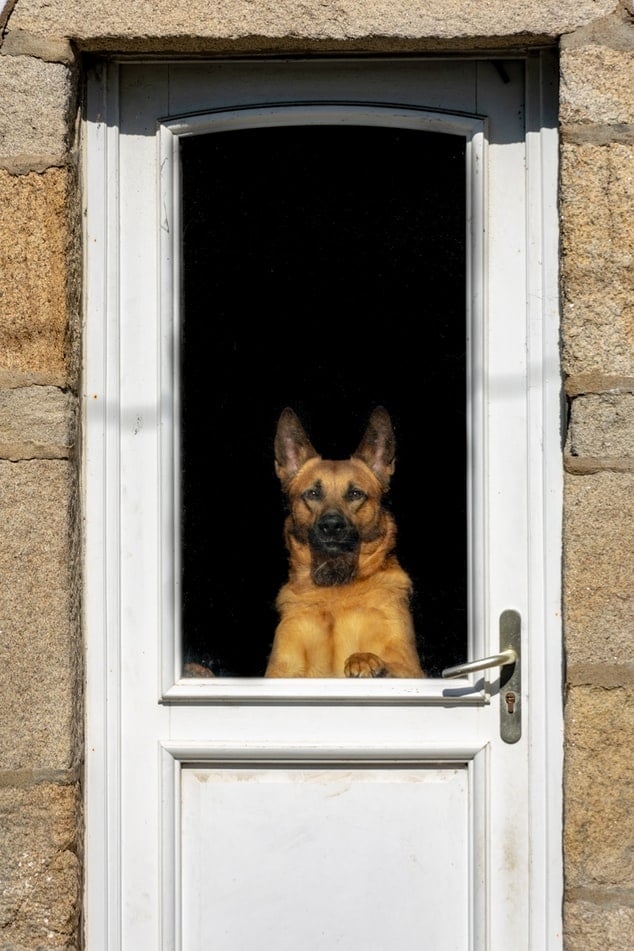
There’s nothing more heartwarming than arriving home from a long day at work and hearing your dog’s friendly bark from the driveway.
If greeting barks were words, they’d be saying “YAY MY PERSON IS HERE HELLO”.
Yes, it may be an inconvenience. But it’s important to remember that your dog is just showing enthusiasm!
Other signs of greeting barks include wagging tail and relaxed stature.
Attention Seeking
Dogs are affectionate animals, and if he wants your attention he will bark for it. Loudly. Not too different to a baby crying for a cuddle, your dog will incessantly bark until you give him what he wants, whether it be treats, strokes, toys, walkies or play.
Compulsive Barking
If your dog is excessively barking and showing other repeated behaviors, such as running to the door repeatedly, it may be due to compulsive barking.
It gets tiring and may sound like a broken record, but it’s important to give your dog lots of attention when barking compulsively.
A lot of the time, this type of bark can be because of separation anxiety or boredom.
Excitement or Frustration
Like any extreme emotion, your dog needs to express his excitement or frustration. A lot of the time, the reason for your dog’s frustration is obvious.
For example, if your dog is on the ground and knows there are treats on the table, but he can’t get to them, then you’re going to have a very vocally frustrated dog.
If he is trapped in one room and there’s his dog pal in another, he may bark excitedly, knowing that his friend is next door.
How to Control This Behavior
With any dog behavior, it’s important to assess the situation and take your dog’s point of view into account. Working out the reason behind the bark is the first step to controlling it.
For example, if your dog is barking at strangers walking past, then restrict his view out the window.
However, it’s important to note that most dog barking is natural and a completely normal response to a lot of every-day things. If it’s not an issue, you don’t need to fix it.
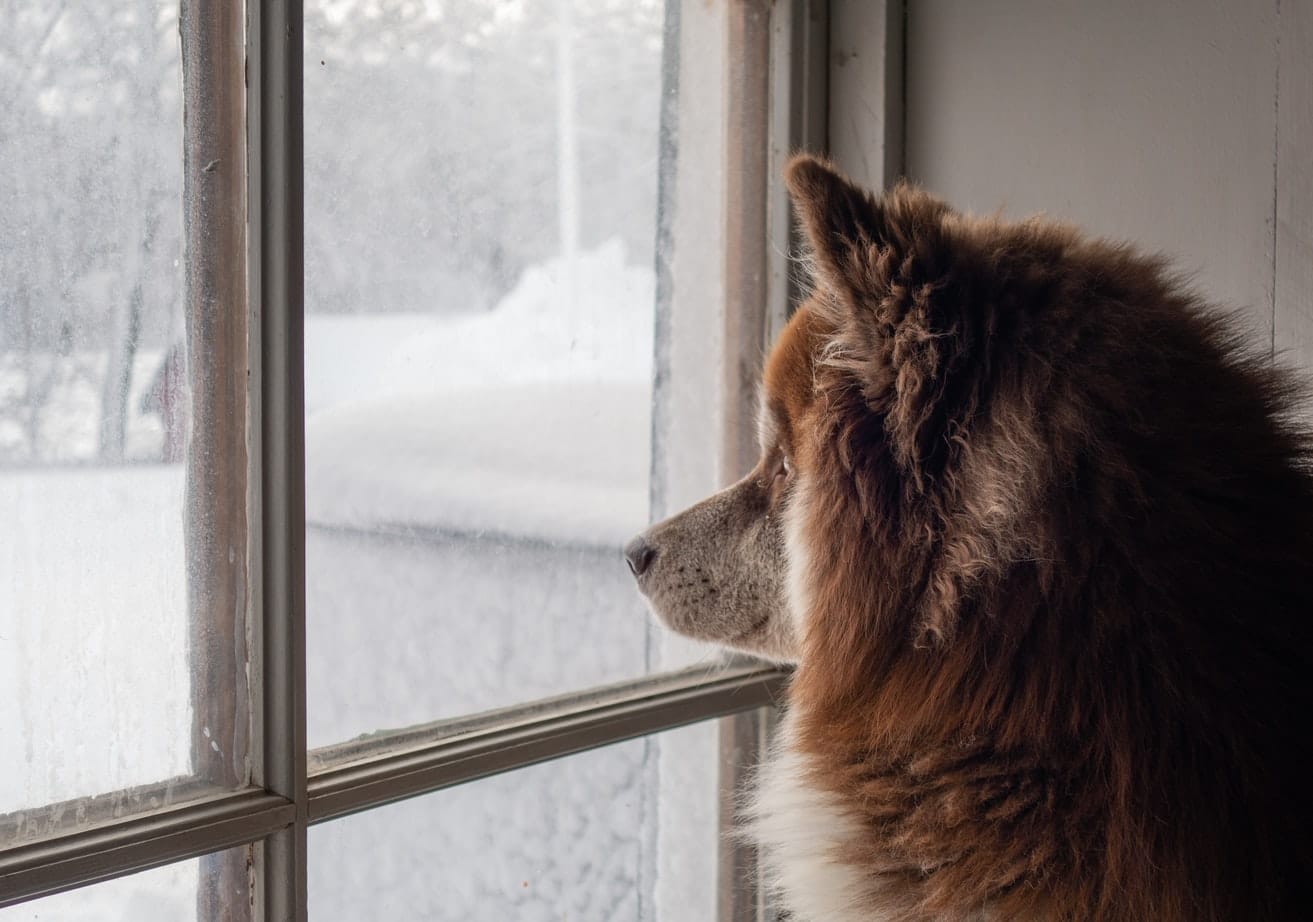
It’s possible to train your dog to be quiet when his barking becomes excessive. If he barks when somebody enters your property, then allow him to bark until you say “quiet”. Be calm and clear, muzzle your dog, and repeat “quiet”.
Then release the muzzle, and call him away from the window. Give him a treat when he does this successfully.
Chances are, this won’t work the first time and it will require a lot of patience.
Stick at it, and the results will show. This is useful for a lot of situations where your dog is barking.
Chewing
Chewing is completely normal for all dog breeds of all ages. It helps tooth development, keeps their gums and jaws strong, and keeps their teeth clean. Dogs love chewing toys, sticks, and bones, and can sit chewing their favorite bone for hours on end.
It’s important for your dog to have chew toys available at all times, as chewing toys have been proven to reduce anxiety in dogs, and to calm them down when excited.
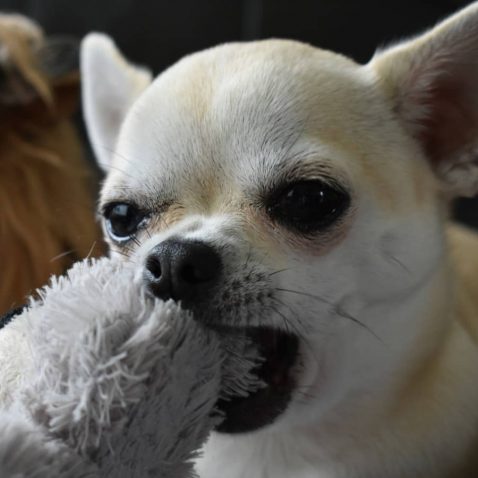
Why is My Dog Chewing My Furniture?
Puppies experience teething, just like babies. As they’re growing their teeth, they want to experiment with them and stimulate their gums. Puppy teething usually ends at around six months of age, but can vary from breed to breed.
For puppies that are having a painful teething experience, it’s recommended to give your puppy an ice cube or a frozen washcloth to chew, to help soothe the area.
One of the main reasons that your dog may be chewing inappropriate items is that they may not have any chew toys available to them. It’s important that your dog has plenty of items that he’s allowed to chew on, as if he doesn’t, he’ll chew whatever is available.
Dogs can also chew when they’re hungry, so ensure your dog has food available and isn’t just chewing because he needs a bite to eat.
Like humans, dogs can suffer from anxiety. This anxiety can be displayed in aggression, barking and chewing. Try to reduce stress in your dog, as punishing, scolding or spanking your dog will make the issue worse.
How to Control This Behavior
If your dog is chewing your furniture, it’s possible to get some anti-dog spray to spray on your furniture.
The preferred method, however, is by discouraging this behavior and encouraging him to chew on a designated toy. Reward your dog with affection or treats when he uses his chew toy, and discipline him when he chews off-limits items.
If your dog chewing is uncontrollable and you need a quick fix, then it may be an option to “dog-proof” your house. Keep shoes and clothes or other items that your dog likes to chew out of reach, in a wardrobe or on a high surface.
Make sure your dog always has something healthy to chew on, whether it be a bone, stick, pig ears or a chew toy.
Mounting and Humping
Most dogs will mount and hump objects, people, or even other animals around the home.
Puppies will hump and mount pretty much everything in sight, but as they get older and reach sexual maturity, they will mount other dogs in a sexual context. It’s important to consider spaying or neutering your dog, as pregnancy in dogs can come with lots of complications.
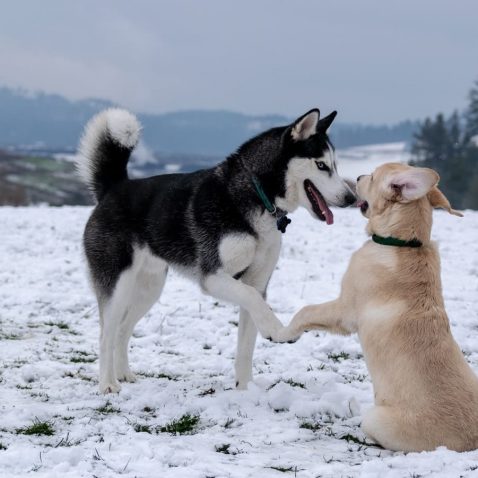
Sexual
This kind of behavior is completely normal for both male and female dogs. Mounting that is sexually motivated will include “flirty” behavior.
For example, his tail will be up, ears backward, and your dog may be licking and pawing and circling.
You must remember that dogs have hormones flowing through their body, and occasionally will feel the urge to spread their seed. This is normal, but if it becomes an issue for you or other animals involved, then read the “How to Control This Behavior” section.
Play
Not all humping has sexual intent. Sometimes, your dog might hump when he’s excited. Dogs do this to relieve stress and to burn off energy, much like running to fetch a stick over and over again.
Dogs can do this if they are bored and need something to entertain them.
It’s completely normal for dogs to hump other dogs, and as long as it doesn’t seem to be a problem for either party involved, then it’s best not to intervene.
Like play fighting, play humping is a part of any dog’s social development.
How to Control This Behavior
Many people think that the quick fix to this behavior is getting your dog “fixed”. However, even after being neutered or spayed, many dogs will still express sexual behaviors.
Make sure you get advice from your veterinarian before making a decision to get your dog spayed or neutered.
If your dog is humping excessively as he’s bored or overexcited, make sure he has another way to relieve his excitement. Play a game of fetch with him, or make sure he has plenty of chew toys available.
It may also be beneficial to train this behavior out of your dog. If your dog stops humping when you say “NO” or “OFF”, then give him a treat and some affection.
Remove the humping target – teach your dog that he isn’t allowed to hump that object/animal.
Summary
Your dog’s thoughts and feelings come out in various different ways, whether they’re chewing your favorite shoes or are humping next doors cat, it’s important to understand why your dog is doing this. Understand his behavior, and you’ll be equipped to manage it.
When your dog is unhappy, extreme behaviors will emerge. Dog behavior can be predictable.
An unhappy dog may become aggressive, so ensure that your canine friend has a stable environment, gets plenty of exercise and affection, and be sure to discipline your dog when necessary.
How do you control your aggressive dog? Do you have any tips you’d like to share with us? Leave a comment below and don’t forget to share this with your fellow dog lovers.
Share the Love
If you found this post useful, please let others know about it by sharing it.
